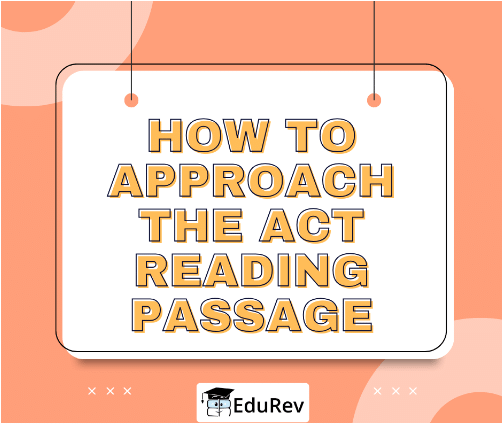How to Approach the ACT Reading Passage | Reading for ACT PDF Download
| Table of contents |

|
| Step 1 |

|
| Step 2 |

|
| Step 3 |

|
| Let's look at an example question from the ACT |

|
| Step 4 |

|
Mastering the art of reading passages for the ACT is crucial for achieving a high score. By breaking down the process step by step, we can uncover effective strategies to tackle the passages with confidence and precision. Understanding these methods thoroughly will enhance comprehension and ultimately lead to better results on the exam.

Step 1
- When you start preparing for the ACT, the first thing to do is to understand how to approach reading the passages.
- Begin by reading the introductory line or blurb at the beginning of the passage. This little blurb gives you some important information like where the passage is from and who wrote it. Understanding this context helps you grasp the main purpose of the passage.
- For example, if the passage is an excerpt from a textbook called "Introduction to Psychology," you can guess that it will likely be full of information, written in an academic style, and aimed at explaining something.
- However, it's essential not to make assumptions before actually reading the passage. Instead, use this blurb to guide you while keeping an open mind about what you'll find inside.
Step 2
Now, let's look at different strategies for reading the passages. There are three options, and you should pick the one that suits you best.

- Option A: Some people find it helpful to read the questions first and then skim the passage. This way, you know what you're looking for while reading. If a question refers to a specific line in the passage, make a note next to that line so you can find it easily when you read. For questions about the main point or purpose of the passage, it's best to circle them and save them for later, after you've read through the passage once and understood it.
- Option B: Other students prefer to skim the passage first, then look at the questions. This way, they get a sense of what the passage is about before diving into the questions. They can still mark important parts of the passage as they read, so they know where to find information when answering questions.
- Option C: Reading the passage closely is the third option, but it's not the most efficient. This involves carefully reading every word of the passage before looking at the questions. However, this approach can waste time, especially since the ACT Reading section requires you to work quickly and efficiently.
Step 3
- Now it's time to answer the questions. Even if you chose Option B earlier, where you skimmed the passage first, it's good to start with the detailed questions first and leave the more general ones for later.
- When you see a question, try to come up with your own answer before looking at the choices given. Sometimes the options can be confusing because they all seem possible. If you have an idea of what the answer might be, it's easier to find it among the choices.
- If you're not sure about an answer after looking at the choices, try to eliminate the ones that are definitely wrong. Remember, there's always only one correct answer, even if some questions seem open to interpretation. For example, a question might ask what a certain word means in a passage. Even if it seems like there could be multiple meanings, there's only one that fits the context perfectly.
Let's look at an example question from the ACT
Helen Hunt Jackson said to Emily Dickinson that "it is wrong to the day you live in, that you will not sing aloud." Which of the following is closest in meaning to this statement?
A. It's bad to keep your poetry to yourself.
B. You should stop writing and become a singer.
C. You should read your work aloud to those who like it.
D. You're not being fair to this era by not sharing your poetry.
The correct answer is D. This is because it matches the idea of "wrong to the day you live in" with "unfair to this era." Answers A, B, and C might seem possible, but they don't match the meaning of the original statement as closely as answer D does.
After you've answered the questions, what's the next step?
Step 4
- Instead of going back and forth between your test booklet and answer sheet, it's faster to answer the questions in your booklet first and then transfer them to the answer sheet later.
- You can do this after finishing each passage to save time. Just make sure to keep an eye on the time so you don't run out before transferring your answers.
- If you're worried about time, start with the passages you feel most comfortable with. This way, you can answer more questions quickly. But be careful not to spend too much time deciding which passage to start with.
That's it! Following these steps can help you manage your time better and tackle the ACT Reading section effectively.
|
18 videos|68 docs|3 tests
|
FAQs on How to Approach the ACT Reading Passage - Reading for ACT
| 1. What are some tips for approaching the ACT Reading passage? |  |
| 2. How can I improve my reading speed and comprehension for the ACT exam? |  |
| 3. What are some common mistakes to avoid when answering questions on the ACT Reading section? |  |
| 4. Are there any specific strategies for tackling specific question types on the ACT Reading section? |  |
| 5. How can I manage my time effectively while completing the ACT Reading section? |  |

|
Explore Courses for ACT exam
|

|
















